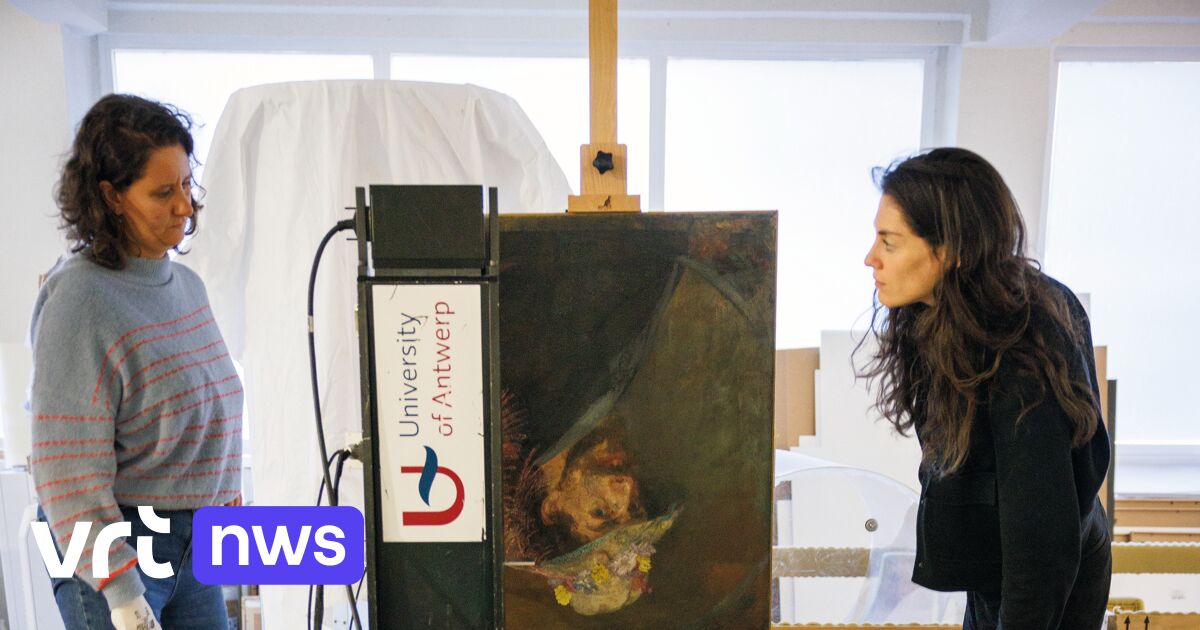2024 marks the 75th anniversary of the death of artist James Ensor, one of the great figures in art history with his unique style. The fact that he is much more than just the “Mask Man” is evident from the numerous exhibitions that are organised. The first is Mo.Z Next in Ostend, the city where Ensor lived and worked. Starting December 16, the exhibition “Rose, rose, rose à mes yeux” will highlight Ensor’s still life. Several other Ensor topics will follow in Antwerp and Brussels next year. 2024 is Ensor year.
Meanwhile, science is not standing still. Researchers from KMSKA in Antwerp and Mu.ZEE in Ostend recently examined a number of Ensor’s important works in art history and materials technology. Not all of them, of course: about 850 paintings have been attributed to the man.
He says that combining all kinds of techniques sometimes leads to amazing results Annelies Ríos Caser. She has a master’s degree in conservation and restoration of paintings and is conducting doctoral research on Ensor materials and techniques at the University of Antwerp. It is also affiliated with KMSKA, where it participates in the Ensor research project.
“Ensor expert Herwig Todts from KMSKA had strong suspicions that Ensor painted over several paintings,” says Ríos-Cassier. “We have been able to confirm this through our research. Ensor painted some paintings entirely, so that nothing could be seen anymore. But in other cases he only modified certain parts, changing their content.
For example, researchers were able to find out that within “Still Life with Chinese Designs” An old man’s study was hidden. Look and compare: The plate and the MA-XRF scanning image from the University of Antwerp:
A good example of partial overpainting is “Self-Portrait with a Flower Hat.” “Ensor painted this in the style of Rembrandt van Rijn, but added the flower hat only years later. This caused a change in style, because the original painting was part of the early dark realist period in which he worked mainly with dark pigments, whereas the flower hat is much lighter Brighter in color and more in keeping with Ensor’s later works.“The technique with which he painted the hat was also quite different,” explains Annelies Ríos-Cácer.
James Ensor had a desire to experiment
Why did Ensor paint entire works? “Ensor’s style changed significantly throughout his life. Perhaps at certain times he was no longer completely satisfied with what he had previously made and wanted to give the no longer relevant canvases a new life by painting another work over them. What is certain is that Ensor had the desire to Experiment, constantly trying new things.
This break in style also had to do with time. In the 19th century, paints appeared on the market that were cheaper and more intense in color. These new possibilities appealed to many artists. Unfortunately, this has also led to materials entering the market that have not been adequately tested. Some of them have changed color or faded.”
Based on these grains of sand, we were able to prove that sixteen-year-old Ensor had painted this work on the beach.
Another special discovery: in the paint of the famous painting “The Pigeon Cart on the Beach” Researchers found grains of sand. “We know from large landscapes that it is almost clear that Ensor made them in his studio, because moving them over and over again would have been a feat. But we often have no idea about smaller objects like this. And based on the grain That sand, we were able to prove that it was sixteen-year-old Ensor who made that painting on the beach,” reveals Annelies Ríos-Cácer.
Grains of sand in the paint of “Pigeon Wagon on the Beach” by James Ensor, KMSKA
Another example: The paint of the painting “Tivoli Café Garden” also contains sand grains. Ensor also painted this work on the beach:
Gray layer, bright colors
In quite a few paintings by James Ensor, researchers found a transparent gray layer over all layers of paint. “In the past, restorers thought it was a layer of dirt and systematically removed it during restoration operations. But optical research now shows that this gray layer is sometimes partly present and partly absent on the same painting. And also that this layer sometimes follows the boundaries of certain shapes. This confirms our suspicions “It is not a layer of dirt, but rather an artistically applied layer.”
The big question is: Did Ensor paint that gray layer himself or did that happen later? In the first case, restorers must leave the layer alone, of course, because Ensor himself would have wanted it that way.
“We are now fully investigating this matter,” says Annelies Ríos Caser. The result of the search in the gray layer will have a significant impact on the paintings. “The Intrigue,” which hangs prominently in KMSKA, is a painting with bright color contrasts, although there is a gray layer to it. If it turns out that this layer was not applied by Ensor, we will have to remove it and the canvas may become brighter.
To restore or ruin?
This brings us to previous restorations of James Ensor’s paintings. Did anything go wrong during the restoration process? Annelies Ríos-Cassier lets out a deep sigh. “Almost all of the Ensor paintings in the KMSKA collection were executed between 1945 and 1996 by several generations of restorers working in the 20th century. The techniques they used destroyed many of the paintings.
Conservators often cut paintings from the stretcher frame around which Ensor has stretched the canvas, and those stretched edges contain a lot of information, such as the structure of the paint layer. In previous restorations, an additional piece of fabric was often glued to the back, again causing loss of information and sometimes flattening of the paint on the front. “They destroyed many paintings beyond repair,” regrets Annelies Ríos Caser.
Watch and watch again
What techniques do modern researchers use to examine the painting and understand all its secrets? “First we look at the painting with the naked eye, with or without a magnifying glass, to discover areas of interest. How the painting is constructed, what layers of paint are present, whether there is any deterioration, and whether there are traces indicating excess paint.
In Ensor’s film The Old Man, researcher Annelise Ríos-Cassier shows how the remains of a basic face can be seen through a fresh layer of paint.
The researchers then look at a panel containing different types of light — different glasses, so to speak — to detect objects that would otherwise remain invisible without the help of advanced optical devices.
Light and scanners
to ultraviolet Rays For example, they scan the surface of Ensor’s works. Infrared light is more suitable for looking deeper into the paint layer. “If a painter makes an underdrawing with a pencil, we can detect that carbonaceous material using infrared imaging,” says researcher Ríos-Cazier.
The board structure is best analyzed using X ray. “The radiographs show how the painting was stretched on the supporting structure and exactly where the nails were located. They also show us the base layer that Ensor used, and whether he modified the composition of the painting afterwards. And even whether the painting we are studying contains an earlier painting that was completely painted by Ensor.” In “Still Life with Drapery,” for example, this technique made clear that he painted it on top of an earlier religious study.
The flower hat was later added to the self-portrait
With the MA-XRF scanner From the University of Antwerp, the researchers can then identify the chemical elements present in the paint layer. For example, Ensor has been shown to have painted some of the flowers in the hat in his self-portrait using cadmium yellow, a pigment that only appeared in his paintings from 1886 onwards. Conclusion: He painted that flower hat later than the rest of the painting.
Ensor’s famous self-portrait currently hangs next to the famous portrait by Rubens, in the gallery’Rare and indispensable” with Flemish masterpieces at MAS in Antwerp. As for the MA-XRF scanner: it has previously been used to conduct comprehensive searches for paintings by Johannes Vermeer, Rembrandt or Rubens.
“Selfie with flower hat by James Ensor, Mu.ZEE
Sometimes it is necessary to remove a small piece of the paint layer for examination in the laboratory. With as little damage as possible: the pieces are always smaller than a millimeter. They come from less visible areas of the painting, such as the edges of the canvas hidden behind the frame.
Of course, researchers also delve into the archives and study, for example, the numerous letters written by James Ensor. These are also valuable sources for Ensor’s study. James Ensor inspires not only the public, who will get their money’s worth in Ensor’s year, but also many scientists.
Would you like to read more about the scientific research into James Ensor’s paintings? A longer article by Els Verweire also appeared in EOS Science Journal.

“Friendly communicator. Music trailblazer. Internet maven. Twitter buff. Social mediaholic.”
















More Stories
Actors Intentionally Cut From Sci-Fi Epic ‘Megalopolis’: ‘Not a Woke Hollywood Movie’
Caroline Rego: “The golden rule is: for every glass of alcohol, one glass of water to replace it!”
Director of 1994’s The Crow Praises Remake’s Failure: ‘It’s a Bloodbath’